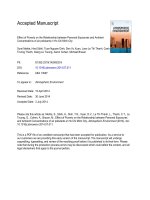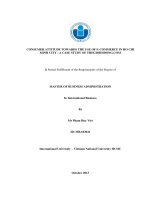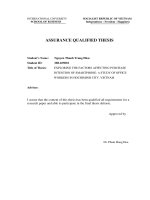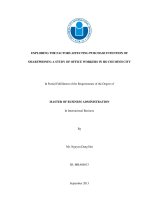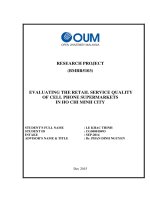Teachers and students’ beliefs of classroom interactions in large non English majored classes at some Universities in Ho Chi Minh city
Bạn đang xem bản rút gọn của tài liệu. Xem và tải ngay bản đầy đủ của tài liệu tại đây (286.53 KB, 16 trang )
Hue University Journal of Social Science and Humanities
ISSN 2588–1213
Vol. 127, No. 6B, 2018, Tr. 135–150;DOI: 10.26459/hueuni-jssh.v127i6B.3945
TEACHERS AND STUDENTS’ BELIEFS OF CLASSROOM
INTERACTIONS IN LARGE NON-ENGLISH MAJORED
CLASSES AT SOME UNIVERSITIES IN HO CHI MINH CITY
Tran Thi Thanh Thuong*
University of Foreign Languages, Hue University
57 Nguyen Khoa Chiem St., Hue, Vietnam
Abstract. This survey study aims to investigate teachers and students’ beliefs of classroom interactions in
non-English major large classes. The participants included 100 teachers of English and 100 non-English
major students. The survey method, more specifically, the questionnaire was chosen as a data collection
tool. The data were then processed using SPSS. The results showed that both the surveyed teachers and
students believed that the classroom interactions involved talks between teachers and students (M = 4.8
and 4.83 for teachers and students, respectively). Besides, the teachers and students similarly considered
that the classroom interactions in non-English large classes were limited because the students did not have
many opportunities for speaking (M = 4.74 and M = 4.70 for both groups). However, the surveyed teachers
tended to think that the students could learn from other peers through interactions (M = 4.39), whereas the
mean score for this statement attained M = 4.0 for students’ responses in the survey. Furthermore, the
teachers reported that the interaction among the students led to the development in cognition and
language learning (M = 3.76), but the students provided a lower appreciation of this issue (M = 3.0). Based
on the findings, the study suggested implications for developing classroom interactions as well as future
studies.
Keywords. Interactions, non-English majored students, large classes
1.
Theoretical framework of the study
The current study adopted two main approaches, namely, the interaction hypothesis and
the socio-cultural theory as conceptual frameworks for investigating the classroom interactions.
Before the approaches are presented, it is necessary to give the working definitions of the key
concepts used in the study.
Definitions of interaction
There are many definitions that have been put forward in the research on interaction.
However, it has become difficult to reach an agreement exactly on what constitutes interaction.
* Corresponding:
Submitted: 12–12–2016; Revised: 13–02–2017; Acceptted: 03–06–2017.
Tran Thi Thanh Thuong
Vol. 127, No. 6B, 2018
Vrasidas and McIsaac (1999, p. 25) pointed out that interaction is “the process consisting of the
reciprocal actions of two or more actors within a given context”. Interactions in large classes are
one of the major challenges for English teachers. For example, Coleman (1989) studied large
classes and English Foreign Language (EFL) learning and pointed out that the the question of
the class size cannot be simplistically answered. It depends much on the context, individual
experiences, and cultural perceptions. Vrasidas and McIsaac (1999) identified four major factors
that influenced interactions in large classes, including the structure of courses, class size,
feedback, and prior experience with computer-mediated communications.
Interaction hypothesis
There are different points of view concerning interaction. The Interaction Hypothesis is
probably the most dominant approach. Long (1983) introduced the Interaction Hypothesis
theory dealing with the role of interaction in the second language learning. According to this
theory, during interactions, participants can create a modified input. The modified input then
facilitates understanding, and this process facilitates comprehension. Besides, through
interaction, learners have the possibility to create the input they need in order to better
understand new information and receive additional input and produce a new output out of it
(Ellis, 1999)
Socio-cultural theory and classroom interactions
The socio-cultural theory developed by Vygotsky (1978) and his colleagues has been
widely applied in the field of education. In the socio-cultural view, a language is not comprised
of internal structures located in the individuals. Rather, it is considered to be fundamentally
social, comprised of linguistic resources whose meanings are both embodied in and constitutive
of our everyday communicative activities and practices. Therefore, language learning is a
fundamentally social process initiating in our social world. Interaction provides mediation and
scaffolding from the more capable learners or teachers to peers or novice ones (Lantolf, 2000).
Interaction, therefore, leads to the development in language learning.
Previous studies relating to classroom interactions
Several researchers have studied classroom interactions. For example, Ralston (2004)
explored how students interact in a classroom context and how these interactions are elicited by
teachers in that classroom context. The researcher also investigated how various forms of
instruction and scaffolding impact the learning of English language learners in a mainstream
classroom. Contrast to Ralston, Muramatsu (2008) investigated the general characteristics and
influence of both teachers and students’ non-native speaker status on the teacher-student
interaction during writing conferences within the context of university-level composition
136
Jos.hueuni.edu.vn
Vol. 123, No. 09, 2016
courses. Clearly, the teacher’s verbal interaction is important in classroom studies. Joan Gorham
(1988) explored a set of teacher’s verbal immediacy behaviours and their interrelation with
classroom learning. The results indicated that the use of different types of verbal immediacy
messages has both a verbal and non-verbal impact on students’ learning. In another study,
Hsien-Chuan Lin (2009) examined students’ experiences and perceptions of multiple interaction
activities, more specifically, self-directed, peer, and teacher feedback in a large multilevel EFL
class in Taiwan. The findings show that large-sized classes cannot be effectively operated to
meet individual student’s needs in improving their language performance. In the Vietnamese
context, Tran and Le (2013) examined the strategies the English teachers used in managing
interactions in large classes. The results indicated that the majority of teachers reported
adopting teamwork, group work, and pair work as strategies to make students more
responsible and active in their study and to increase classroom interactions.
In general, various aspects of classroom interactions have been explored; however,
similarities and differences in teachers and students’ beliefs of classroom interactions,
especially, their beliefs of interactions in large non-English major classes remain a question for
investigation.
2.
Methodologies
Research participants
The participants included two groups: teachers and students. 100 teachers teaching nonEnglish major large classes from four universities in Ho Chi Minh City were invited to
participate in this study. They consisted of 76 females and 24 males, aged from 25 to 55 years
with from 2 to 15 teaching experience years. The other group included 100 third-year students
also from these four universities. They consisted of 65 females and 35 males, aged from 20 to 21,
with about 10 years of studying English.
Survey research method
The survey research was chosen for the current study. It is a specific type of field study
that involves the collection of data from a sample of elements drawn from a well-defined
population through the use of a questionnaire (Visser, Krosnick & Lavrakas, 2000, p. 223). Due
to a large number of participants in this study, a questionnaire was chosen to collect data for the
current
study.
The
surveys
were
generally
standardized
to
ensure
that
they
had reliability and validity and the results could be generalized to a larger population.
Questionnaire for students
A written questionnaire was used in order to gain a general understanding of students’
137
Tran Thi Thanh Thuong
Vol. 127, No. 6B, 2018
beliefs towards interactions in non-English major large classes. The designed questionnaire
consisted of 38 questions. Each question is measured on the 5-point Likert scales, from strongly
disagree to strongly agree. The items of the questionnaire were categorized into four clusters,
namely, the class size and classroom interactions, roles of teachers in classroom interactions in
large classes, roles of students in interactions in large classes, and roles of the target language.
After the pilot research, the main study was carried out. The time for the students to complete
the questionnaires was within 30 minutes, but they had 4 hours to return the questionnaire to
the data collector.
Questionnaire for teachers
The clusters of the teacher questionnaire are similar to those of the student questionnaire.
The time for the teachers to complete the questionnaires was within 20 minutes and they also
had 4 hours to return the questionnaire to the data collector.
The data gained from the questionnaires for both teachers and students were analysed
using the Statistical Package for Social Sciences (SPSS) for quantitative analysis.
3.
Results and discussion
Before the findings were analysed, the reliability of the questionnaires was measured
using Cronbach’s alpha for internal consistency. Cronbach's Alpha coefficients of all scales of
both teachers and students’ responses were larger than 0.6 and, therefore, achieved reliability.
The items in the questionnaires were put into two main themes: teachers' beliefs of classroom
interactions in non-English major large classes and students’ beliefs of the same topic. They are
presented in Tables 1–8 followed by the discussion on similarities and differences in teachers
and students’ belief of classroom interactions in non-English major large classes.
3.1. Class size and classroom interactions
The class size obviously affected the interactions in the language classroom. Their
responses are presented in the following Table 1 and Table 2.
Table 1. Teachers' beliefs of class size and classroom interactions
N = 100
Statements
1. A language class with from 40
students or more reduces the
speaking opportunities for
students to interact with each
138
Strongly
Disagree
Neutral
Agree
Strongly
agree
Mean
Disagree
0
0
45
33
22
3.77
Jos.hueuni.edu.vn
Vol. 123, No. 09, 2016
other.
2. It is difficult for the teacher to
interact with students and vice
versa in non-English major large
classes.
3. There is not enough time for
students to interact with one
another in a large class.
4. In a large class, teachers are
usually unable to manage
classroom interactions.
5. Classroom interactions in nonEnglish large classes are not
effective because students do not
have a lot of opportunities to talk
to other students
6. The atmosphere in a large class
encourages students to interact.
7. In a large class, students can
learn from other peers through
interactions.
8. Teacher-students interactions are
necessary for teaching nonEnglish large classes.
9. Interactions among students in
a large class lead to
development in cognition and
language learning.
10. Classroom interactions include
talking between teacher and
students.
11. Classroom interactions include
talking between students and
students
0
7
49
26
18
3.55
0
0
14
45
41
4.27
0
0
0
45
55
4.55
0
0
0
26
74
4.74
0
7
49
16
28
3.65
0
0
3
55
42
4.39
0
0
0
37
63
4.63
0
0
48
28
24
3.76
0
0
0
20
80
4.83
0
0
0
41
59
4.59
Table 2. Students’ belief of class size and classroom interactions
N = 100
Statements
1. A language class with from 40
students or more reduces the
speaking
opportunities
for
students to interact with each
other.
2. It is difficult for the teacher to
interact with students and vice
Strongly
Disagree
Disagree
Agree
Strongly
agree
Mean
Neutral
0
6
38
33
23
3.73
0
8
46
42
4
3.42
139
Tran Thi Thanh Thuong
versa in non-English major large
classes.
3. There is not enough time for
students to interact with one
another in a large class.
4. In a large class, teachers are
usually unable to manage
classroom interactions.
5. Classroom interactions in nonEnglish large classes are not
effective because students do not
have a lot of opportunities to talk
to other students
6. The atmosphere in a large class
encourages students to interact.
7. In a large class, students can
learn from other peers through
interactions.
8. Teacher-students interactions are
necessary for teaching nonEnglish large classes.
9. Interactions among students in
a
large
class
lead
to
development in cognition and
language learning.
10. Classroom interactions include
talking between teacher and
students.
11. Classroom interactions include
talking between students and
students
Vol. 127, No. 6B, 2018
0
0
38
24
38
4
0
0
0
47
53
4.53
0
0
0
30
70
4.7
0
6
39
53
2
3.51
0
2
30
34
34
4
0
0
6
38
56
4.5
0
41
20
37
2
3
0
0
1
15
84
4.8
0
0
0
46
54
4.54
The results showed that both surveyed teachers and students believed that in large
classes, students can learn from their peers through interactions (M = 4.63 and M = 4.0 for
teachers and students, respectively). This indicates a high level of agreement with both
interactionism and socio-cultural theory because, through peer interactions, learners can have
both language input and verbal mediation to think and carry out the task at hand. Furthermore,
the surveyed teachers and students’ responses achieved mean scores of 3.76 and 3.0 for the
statement that interactions led to the development of cognition and language learning. Clearly,
more teachers had these beliefs than students, and both groups appreciated the principle of
socio-cultural theory in terms of the connection between the level of thinking and social talks.
Besides, the survey showed that classroom interactions involved talks between teachers and
students (M = 4.83 and 4.8 for teachers and students, respectively).
140
Jos.hueuni.edu.vn
Vol. 123, No. 09, 2016
3.2. Roles of teachers in classroom interactions in large classes
Clearly, teachers play important roles in promoting classroom interactions. Table 3 and
Table 4 present the data of the roles of teachers.
Table 3. Teachers' belief of the roles of teachers in classroom interactions in large classes
N = 100
Statements
Strongly
agree
Mean
Strongly
Disagree
Disagree
Neutral
Agree
0
0
17
51
29
4.18
0
20
45
32
3
3.18
0
0
17
42
38
4.27
0
0
22
59
19
3.97
0
0
0
16
84
4.84
0
0
0
32
68
4.68
0
3
19
56
22
3.97
0
0
3
45
52
4.49
0
0
4
56
40
4.36
12. The atmosphere in non-English
major large classes is teachercentered.
13. In
non-English
major
large
classes, teachers should talk
less to give opportunities for
students to interact more.
14. Teachers should use audiovisual
aids
in
non-English
major large classes to promote
classroom interactions.
15. Classroom interactions are to
promote learners’ processing
capacity.
16. In
non-English
major
large
classes, students should
be
scaffolded by teachers.
17. The teacher should provide
language input in non-English
major large classes.
18. The teacher should encourage
shy students in non-English
major large classes to talk
more.
19. Teachers should use guiding
questions to help students with
their language learning in nonEnglish major large classes.
20. Interactions
in
non-English
141
Tran Thi Thanh Thuong
major
large
classes
Vol. 127, No. 6B, 2018
create
language input and meaningful
contexts for language learning.
Table 4. Students' belief of the roles of teachers in classroom interactions in large classes
N = 100
Statements
12. The atmosphere in non-English
major large classes is teachercentered.
13. In non-English major large
classes, teachers should talk
less to give opportunities for
students to interact more.
14. Teachers should use audiovisual aids in non-English
major large classes to promote
classroom interactions.
15. Classroom interactions are to
promote learners’ processing
capacity.
16. In non-English major large
classes, students should be
scaffolded by teachers.
17. The teacher should provide
language input in non-English
major large classes.
18. The teacher should encourage
shy students in non-English
major large classes to talk
more.
19. Teachers should use guiding
questions to help students with
their language learning in nonEnglish major large classes.
20. Interactions in non-English
major large classes create
language input and meaningful
contexts for language learning.
Strongly
Disagree
Neutral
Agree
Strongly
agree
Mean
Disagree
0
0
18
62
20
4.02
0
3
42
54
1
3.53
0
3
15
58
24
4.03
0
3
43
53
1
3.52
0
0
0
22
78
4.78
0
0
3
42
55
4.52
0
0
14
52
34
4.2
0
3
43
52
2
3.53
0
0
11
57
32
4.21
According to the Interaction Hypothesis theory, opportunities for students to talk in the
classroom are vital to the language learning process. Teachers and students’ responses (M =
3.18; 3.53, respectively) showed a rather high level of agreement of their beliefs to the issue.
There were more students who thought that teachers should talk less in the classroom.
142
Jos.hueuni.edu.vn
Vol. 123, No. 09, 2016
However, the two groups gave a very significant appreciation to the scaffolding of teachers to
students in interactions (M = 4.84 for teachers and M = 4.78 for students) as in line with the
socio-cultural theory, in which teachers are considered to be more knowledgeable. Also, both
groups believed that the language input from teachers was necessary for students’ language
learning (M = 4.68; 4.52, respectively).
3.3. Roles of students in interactions in large classes
Table 5 and Table 6 show the findings from the questionnaire regarding students’ roles in
classroom interactions.
Table 5. Teachers' belief of the roles of students in interactions in large classes
N = 100
Statements
21. It is difficult for students
in non-English major
large classes to interact
with the teacher because
students are often too
passive.
22. Students feel shy to
speak in non-English
major large classes.
23. In non-English major
large classes, students
would not like to
interact because the
input level of students is
different.
24. In non-English major
large classes, students
can exchange ideas with
the teacher.
25. Student
to
student
interaction takes place in
non-English major large
classes when teachers set
language items and
group students into
pairs or groups.
26. Peer interaction in nonEnglish
major
large
classes
is
necessary
because students may
Strongly
Disagree
Disagree Neutral
Strongly
agree
Mean
Agree
0
0
0
19
81
4.81
0
0
6
56
38
4.32
0
6
87
7
0
3.01
0
0
20
70
10
3.9
0
0
23
73
4
3.81
0
0
9
81
10
4.01
143
Tran Thi Thanh Thuong
27.
28.
29.
30.
31.
32.
33.
34.
144
not have opportunities
to talk to classroom
teachers.
Peer interaction in nonEnglish
major
large
classes helps students
understand the lesson
better.
Peer interaction in nonEnglish
major
large
classes
mediates
students’
thinking
process.
The
interactional
collaboration
among
peers can lead to second
language learning
Peer
interaction
provides language input
for students in nonEnglish
major
large
classes.
Peer interaction creates
an
active
learning
environment.
The
modified input
created within classroom
interactions
can
be
facilitating in explaining
linguistic forms that
learners found difficult
to understand.
In non-English major
large
classes,
the
environment is safer
because students do not
have to answer every
question.
Students play the role of
negotiators
in
peer
interactions.
Vol. 127, No. 6B, 2018
0
0
9
81
10
4.01
0
0
3
17
80
4.77
0
0
0
39
61
4.61
0
0
0
87
13
4.13
0
0
6
27
67
4.61
0
0
0
30
70
4.7
0
0
0
51
49
4.49
0
0
7
85
8
4.01
Jos.hueuni.edu.vn
Vol. 123, No. 09, 2016
Table 6. Students' belief of the roles of students in interactions in large classes
N = 100
Statements
21. It is difficult for students in
non-English
major
large
classes to interact with the
teacher because students are
often too passive.
22. Students feel shy to speak in
non-English
major
large
classes.
23. In non-English major large
classes, students would not
like to interact because the
input level of students is
different.
24. In non-English major large
classes, students can exchange
ideas with the teacher.
25. Student to student interaction
takes place in non-English
major large classes when
teachers set language items
and group students into pairs
or groups.
26. Peer interaction in non-English
major large classes is necessary
because students may not have
opportunities to talk to
classroom teachers.
27. Peer interaction in non-English
major large classes helps
students understand the lesson
better.
28. Peer interaction in non-English
major large classes mediates
students’ thinking process.
29. The interactional collaboration
among peers can lead to
second language learning
30. Peer
interaction
provides
language input for students in
non-English
major
large
classes.
31. Peer
interaction
creates an
Strongly
Disagree
Neutral
Agree
Strongly
agree
Mean
Disagree
0
0
0
20
80
4.8
0
0
4
82
14
4.1
0
8
62
30
0
3.22
0
0
19
70
11
3.92
0
7
86
7
0
3
0
0
40
56
4
3.64
0
0
8
74
18
4.1
0
0
1
65
34
4.33
0
0
1
56
43
4.42
0
0
19
71
10
3.91
0
0
8
50
42
4.34
145
Tran Thi Thanh Thuong
Vol. 127, No. 6B, 2018
active learning environment.
32. The modified input created
within classroom interactions
can
be
facilitating
in
explaining linguistic forms
that learners found difficult to
understand.
33. In non-English major large
classes, the environment is
safer because students do not
have to answer every question.
34. Students play the role of
negotiators
in
peer
interactions.
0
0
0
40
60
4.6
0
0
0
69
31
4.31
0
0
0
89
11
4.11
Both the interactionism and socio-cultural theory emphasize the roles of peers in
interactions and learning. The data from the questionnaire for teachers and students reflected
the features of both approaches. The surveyed teachers and students gave nearly the same
evaluation of the roles of peers in interactions (M = 4.01 and 4.10) for this issue. The teachers’
responses to the statement that peer interaction provides the input attained a mean score of
4.13, which is higher than the score of 3.91 from the students’ responses. The interaction
hypothesis theory states that the modified input facilitates language learning. The data from the
two tables above show a similar agreement for both groups (M = 4.7 and 4.6, respectively).
3.4. Roles of the target language in classroom interactions
Clearly, the target language use is the goal of any EFL classes. To find out the belief of
teachers and students about the roles of the target language in classroom interactions, a
questionnaire was given to both teachers and students. The data are presented in Table 7 and
Table 8.
Table 7. Teachers' belief of the roles of the target language
N = 100
Statements
35. Classroom
interactions
should be mainly in English
in the process of teaching in
large classes for non-English
majors.
36. The target language is used
as
a
social
tool
for
146
Strongly
Disagree
Neutral
Agree
Strongly
agree
Mean
Disagree
0
0
29
68
3
3.74
0
0
25
70
5
3.8
Jos.hueuni.edu.vn
Vol. 123, No. 09, 2016
communication
in
classrooms.
37. Throughout the process of
interaction in the target
language, learners have the
possibility to create the input
they need in order to better
understand new information.
38. Teachers should use only
English in non-English major
large classes so that students
can have a rich language
environment.
0
0
31
69
0
3.69
0
0
0
48
52
4.52
Table 8. Students' belief of the roles of the target language
N = 100
Statements
35. Classroom interactions should
be mainly in English in the
process of teaching in large
classes for non-English majors.
36. The target language is used as
a social tool for communication
in classrooms.
37. Throughout the process of
interaction in the target
language, learners have the
possibility to create the input
they need in order to better
understand new information.
38. Teachers should use only
English in non-English major
large classes so that students
can have a rich language
environment.
Strongly
Disagree
Neutral
Agree
Strongly
agree
Mean
Disagree
0
0
18
62
20
4.02
0
3
42
54
1
3.53
0
3
15
58
24
4.03
0
3
43
53
1
3.52
Clearly, a rich environment of the target language helps learners much in the process of
learning it. In the socio-cultural theory, a language is a tool for social communication and the
expression of thoughts. More teachers’ responses agreed with this fact: M = 3.8, as compared
with M = 3.52 for students’ responses. The statement that teachers should use only English in
non-English major large classes achieved a very high mean score from the teachers’ answers (M
= 4.52) and a rather low from students’ (M = 3.52).
147
Tran Thi Thanh Thuong
3.5.
Vol. 127, No. 6B, 2018
Comparison of teachers and students’ beliefs of classroom interactions in non-English
major large classes
Similarities
From the data presented in the tables, it can be concluded that both surveyed teachers
and students believed that classroom interactions involved talks between teachers and students
(M = 4.8 and 4.83 for teachers and students, respectively). Besides, the teachers and students
similarly considered that the classroom interactions in non-English large classes were limited
because students did not have many opportunities for speaking (M = 4.74 and M = 4.7,
respectively). In terms of the role of teachers in classroom interactions, the two groups of
participants agreed that teachers should talk less to give more opportunities for students
(M = 3.18 for both groups). Regarding the role of students in classroom interactions, the mean
scores for teachers and students’ answers were almost the same, at 4.81 and 4.80, respectively.
Furthermore, the mean scores of the two groups were nearly equal (4.7 and 4.6) when they both
agreed on what modified input, created within classroom interactions could be facilitating in
explaining linguistic forms for learners. In general, the surveyed teachers and students
reiterated the important role of the components of classroom interactions which provided the
language input (Long, 1983) and negotiation for linguistic forms (Ellis, 1999).
Differences
There were four differences in the teachers and students’ beliefs of the classroom
interactions in non-English major large classes.
First, the surveyed teachers tended to think that students could learn from other peers
through interactions, as pointed out by Vygotsky (1978) and Lantolf (2000). However, the mean
score for teachers’ responses was 4.39, whereas this value for the students was 4.0. Furthermore,
teachers also considered that interactions among students led to the development in cognition
and language learning (M = 3.76), but students provided a lower appreciation of this issue
(M = 3.0).
Second, while teachers valued the teacher centredness and their dominant roles in class
(M = 4.18) and guided students (M = 4.49), students rated these roles of teachers at lower scores,
with their mean of 4.02 and 3.53, respectively. Students, however, expected teachers to scaffold
them (M = 4.78) and to provide language input (M = 4.21).
Third, teachers gave a higher evaluation of student-student interactions if they provided
with language items and arranged students in groups or pairs (M = 3.81 and M = 3.0
respectively).
148
Jos.hueuni.edu.vn
Vol. 123, No. 09, 2016
Finally, there was a noticeable discrepancy between the teachers and students’ beliefs of
whether only the target language should be used in the classrooms. The mean score of the
teachers’ answer was 4.52, whereas it was only 3.52 for students’ answer. Overall, the
differences in the teachers and students’ belief level of components of classroom interactions in
large classes confirmed the findings of the study by Hsien-Chuan Lin (2009).
4.
Conclusions
The findings of the study revealed that the teachers and students tended to have different
levels of belief of classroom interactions in terms of the roles of teachers, roles of students, class
size, and use of the target language. In general, the surveyed teachers and students tended to
believe that the classroom interactions involved talks between teachers and students and that
classroom interactions in non-English large classes were limited because students did not have
many opportunities for speaking. Despite these limited opportunities, both teachers and
students considered that classroom interactions provided language input and negotiation for
the linguistic forms for students. However, the surveyed teachers gave higher appreciation to
peer interactions and development in cognition and language learning thanks to classroom
interactions.
The findings from this study implicated a slight mismatching in teachers and students’
beliefs of interactions in large classes at some universities in Ho Chi Minh City. However, they
both considered classroom interactions to be of great importance in the process of learning
English. Therefore, interactions should be promoted in language classes, especially, large
classes for non-English major students. Due to the scope of the paper, the findings of the role of
the mother tongue were not reported, and the data from interviews and the audio-recordings of
classroom interactions were not included. It would show a more comprehensive understanding
of the teachers and students’ beliefs of classroom interactions if those data sources could be
presented. Further research can dwell into such factors of classroom interactions as patterns and
turn taking.
References
1. Vrasidas V. C. (1999), Student and teacher perceptions of interaction in online computer-mediated
communication. Educational Media International, 36(2), 121–131.
2. Muramatsu Y. (2008), The role of Coleman, H. (1989), How Large are Large Classes? Lancaster-Leeds
Language Learning in Large Classes Research Project, Report No. 4.
3. Ellis R. (1999), Learning Second Language through Interaction. Amsterdam: John Benjamin
149
Tran Thi Thanh Thuong
Vol. 127, No. 6B, 2018
4. Hsien-Chuan Lin (2009), A case study of how a large multilevel EFL writing class experiences and
perceives multiple interaction activities. A Dissertation Submitted in Partial Fulfillment of the
Requirements for the Doctor of Philosophy Degree. Department of Curriculum and Instruction in the
Graduate School, Southern Illinois University, Carbondale.
5. Gorham J. (1988), The relationship between verbal teacher immediacy behaviors and student
learning, Communication Education, 37:1, 40–53, />6. Lantolf J. P. (2000), Introducing socio-cultural theory. In: Lantolf, J. P., ed. Socio-cultural theory and second
language learning. Oxford University Press, 1–26.
7. Long M. H. (1983), Native Speaker/ Non-native Speaker Conversation and the Negotiation of
Comprehensible Input.Applied Linguistics 4, 126–141.
8. McIsaac M. S., Blocher, J. M. (1999), Mahes native-speaker status and cultural background: a
multidimensional case study of teacher-student interaction in English composition classes. A Doctoral
Dissertation Submitted to The University of Arizona.
9. Ratson B. A. (2010), Interaction and language development of ELL students in mainstream classrooms. A
thesis submitted in partial fulfillment of the requirements for the Master of Science to the Graduate
College University of Nevada, Las Vegas.
10. Tran Thi Thanh Thuong, Le Pham Hoai Huong (2013), Managing strategies in teaching English in
large classes at College of Economics, Hue University Journal of Science, 10(88), 69–76.
11. Visser P. S., Krosnick J. A., Lavrakas P. J. (2000), Survey research. StanfordUniversity.
12. Vygotsky L. (1978). Mind in society: The development of higher psychological processes (Ed. By M. Cole, V.
John-Steiner, S. Scribner, E. Souberman). Cambridge, MA: Harvard University Press.
150




